Norm the Artist, Oughtist, and Ne'er-do-well
Here are my central art-beliefs:
1. Art should concern itself
as much with behavior as it does with appearance.
2. Some of the best art happens
when behavior and appearance are completely at odds with each other.
3. Economy of means is a critical
part of aesthetics.
4. Art functions best, and is
most needed, outside of galleries and museums.
Curriculum vitae
Short Autobiography and Credo
Here's some of the stuff I've
done over the years (Click on the thumbnail for a bigger picture):
- First Tighten Up on the Drums
(1969). My first major electronic project, built
specifically for the 1969 E.A.T. group exhibition entitled "Some More
Beginnings", in New York City. Using several hundred early-vintage
digital integrated circuits donated by the Sprague Electric Company, I
set about creating a machine which would autonomously generate shimmering
light patterns similar to those seen at the bottoms of swimming pools.
Much of the ten months spent making the machine involved teaching myself
electronics. When it was finally done, the patterns generated turned out
to be more reminiscent of clouds swirling past an airplane porthole, or
rain dripping down a window-pane. Looking back now, I realize it is an
early Cellular Automata experiment. Materials: Plexiglas, custom electronics,
and small neon bulbs. Owned by the National Gallery of Canada, Ottawa.
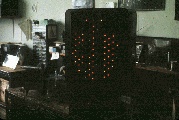 First Tighten Up on the Drums
First Tighten Up on the Drums
- Dervish (1974).
A sound installation wherein modulated white noise seems to rotate around
a central observer within a circular array of ceiling-mounted speakers.
The movement alternatively speeds up, slows down, and reverses, while an
audio filter correspondingly shifts the timbre of the noise. The impetus
for building the piece was a budding interest in the simulation of motion
using regularly-spaced, static sources. In this case, my interest spilled
over from light into sound. Materials: Plexiglas, public address speakers,
and custom electronics. Owned by the National Gallery of Canada.
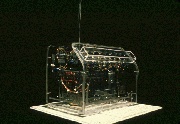 Dervish (detail of controller)
Dervish (detail of controller)
- Menage (1974).
An Electric Gallery (Toronto) installation consisting of four robots crawling
back and forth along separate ceiling tracks, and a fifth floor-situated
robot. Each machine has a rotating antenna-like scanner, designed to point
itself toward any strong light-source, and a spotlight mounted at the center
of its scanner. Ceiling robots therefore tend to lock into each others'
gazes until their non-responsive track-motors pull them apart. Given the
simplicity of the control principles, the group behavior is surprisingly
complex.
Built in homage to W. Grey Walter, an early pioneer in brain research and
the artificial modelling of organic behavior. Materials: Plexiglas, stepping
motors, and custom electronics. Owned by myself.
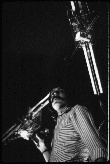 Menage
Menage
- Four-Letter Word Generator
(1974). This work
harkens back conceptually to my 1966 random-number generator, with 4-letter
words replacing the single digit readout. Although technically more sophisticated,
it is strategically less complex, depending simply upon a few out-of-sync
oscillators for its choice of the next word. All the words chosen are pronounceable,
although not of any particular language. Materials: Plexiglas, neon alphanumeric
readout tubes, and custom electronics.
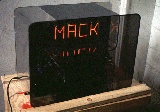 Four-Letter Word Generator
Four-Letter Word Generator
- Let Fly (a.k.a. So Far So Good) (1974).
A small table-top work. Tiny booms with strobing light-emitting diodes
at their ends move in stochastic sequence and direction. Materials: Plexiglas,
light-emitting diodes, motors, and custom electronics. Owned by Art Bank/
the Canada Council, Ottawa.
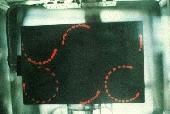 Let Fly
Let Fly
- Splish Splash Two (1975).
A large (8 ft.x 40 ft.) logic/light mural commisioned by the Canadian Broadcasting
Corporation for the foyer of its Vancouver offices. The mural simulates
raindrops falling randomnly on the surface of a quiet pond. Materials:
aluminum, polycarbonate plastic, incandescent bulbs, and custom electronics.
Owned by the Canadian Broadcasting Corporation, Vancouver, B.C.
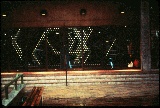 Splish Splash Two
Splish Splash Two
- Facing
Out Laying Low (1977). A microcomputer-controlled,
interactive robot. It surveys its surroundings from a fixed point, and
responds to activity it finds "interesting" with a variety of
audio responses (the first version employed coded brownian trills, while
later versions used synthesized voice). It has gone through six major hardware/software
revisions, the most recent being a complete hardware/software re-build after the
original work went missing. Materials: Plexiglas, motors, custom electronics. Owned by
myself. If you'd like to see the program (in Motorola 6800 Assembler)
which gave the original F.O.L.L. its particular behaviour,
click here.
 Facing Out Laying Low
Facing Out Laying Low
- Departure (1977).
A moving re-enactment of the famous Michaelangelo painting. The viewer
puts pennies into a slot, whereupon black curtains open revealing Adam's
arm resting on a lush field of Viridian green. A light goes on offstage
right, and Adam's arm reaches up toward it. Then God's arm swings down
and **ZAP** , a 1 cm. spark jumps from finger tip to finger tip!! Finally
a light goes on offstage left as the curtains close. All for seven cents.
Materials: wood, oil-paint, motors, textiles, custom electronics. Owned
by Medtronic, an artificial pacemaker manufacturing company in Minneapolis,
Minnesota.
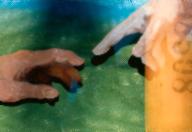 Departure (detail)
Departure (detail)
- Final Approach (1979).
A sound installation involving a grid of nine ceiling-mounted speakers
continuously rotating at the ends of synchronized booms. My intent here
was to explore a hybrid system using both real, and virtually-moving, sound.
Only one speaker is active at a given time. Sound switches between speakers
only when they are in close proximity, and a randomizing circuit gives
the go-ahead. The result is the sound of a fly, or an airplane, buzzing
overhead in complex arabesques. Materials: aluminum, motors, public- address
speakers, electronics. Owned by myself, but now so cannabalized as to require
rebuilding.
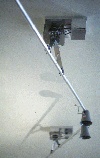 Final Approach
Final Approach
- Funky Isn't Junky (1982).
An installation of five or six crude sound-producing machines synchronized
by a "conductor" machine. As a reaction to ten years of intense
personal involvement with electronic hi-tech, I built the work almost entirely
with pre-40's technology. At the end of the sequence, the piece appears
to break down, dramatizing my love for the vulnerability of machine-kind.
Materials: wood, motors, steel, plexiglas, aluminum, speaker, custom electronics.
Owned by myself.
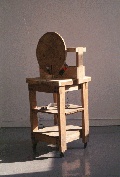 Funky Isn't Junky (detail)
Funky Isn't Junky (detail)
- Funny Weather (1983).
An artificial weather-system comprised of a number of fans of different
shapes and sizes which are each turned on and off in response to drafts
created by the other fans. Created site-specifically for the store-front
window of a small artist-run gallery ("Eye Revue") in Toronto.
Materials: aluminum, electric fans, relays. No longer in exsitence.
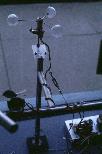 Funny
Weather (detail)
Funny
Weather (detail)
- Hearsay (1985).
A telecommunications event based upon the children's game whereby a secret
message is whispered from person to person till it arrives back at its
originator. In this case a message was sent around the world in 24 hours,
roughly following the sun, via a global computer network (I. P. Sharp Associates).
Each of the eight participating centres was charged with translating the
message into a different language before sending it on. The whole process
was monitored at Toronto's A-Space. You can examine the text file compilation
of the results by clicking here.
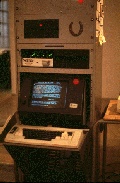 Hearsay
(detail of A-Space installation)
Hearsay
(detail of A-Space installation)
- Telephonic Arm Wrestling (1986).
A collaborative telecommunications project undertaken by myself and fellow artist,
Doug Back. The idea was to allow contestants in two different cities to
arm-wrestle, using motorized force-transmitting systems interconnected
by a telephone data link. First succcessfully exhibited during a 1986 link-up
between the Canadian Cultural Centre, Paris, and the Artculture Resource
Centre, Toronto. Sponsored by the McLuhan Programme, University of Toronto.
Materials: Steel, Plexiglas, torque wrenches, motors, and custom electronics.
Owned by Doug Back and myself.
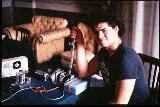 Telephonic Arm Wrestling (shown here with technician,
Ian McGuigan)
Telephonic Arm Wrestling (shown here with technician,
Ian McGuigan)
- The Helpless Robot (1987-96).
Another interactive work, except that this one has no motors, but instead
must depend upon its synthesized voice to encourage people to move it as
it would "like". I built it primarily as an apparatus to test
out different techniques of automatic knowledge-building; in this case,
the machine attempts to assess and predict human behavior. Like Facing
Out Laying Low, it is essentially an unfinishable work. Materials:
plywood, angle-iron, proximity sensors, modified 80386 computer, and custom
electronics. Click here for the original technical
details on both hardware and software (its brain is now being updated using
more compact and robust microprocessors). It also speaks Spanish and French.
Owned by the Agnes Etherington Art Centre, Kingson, Ontario.
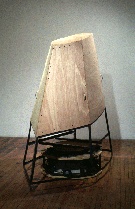 The Helpless Robot
The Helpless Robot
- Them Fuckin' Robots (1988)
.
Fellow artist Laura Kikauka and I each built an electro-mechanical sex
machine (hers, female; mine, male) without consulting each other on the
particulars, apart from the dimensions of the engaging organs. We then
brought these two machines together for a public performance. The male
machine, the first and last anthropomorphic robot I've ever built, responds
to the magnetic fields generated by the female organ, thereby increasing
its rate of breathing and moving its limbs, simultaneously charging a capacitor
to strobing "orgasm". The female machine, on the other hand,
is a diverse assemblage including a boiling kettle, a squirting oil pump,
a twitching sewing machine treadle, and huge solenoid on a fur-covered
board -- all hanging from an old bedspring and energized by an electronic
power sequencer. Materials: various found objects, aluminum, steel, motors,
springs, solenoids, and custom electronics.
Owned by The Funny Farm (Laura Kikauka) and myself.
 Them Fuckin' Robots (detail of male)
Them Fuckin' Robots (detail of male)
I've also collaborated in a number
of telecommunications projects initiated by other artists. Here are three:
- Worldpool (1978-1979) -- Bill Bartlett (Pender Island,
B.C.) and Willoughby Sharp (New York City) inspired the formation of a Toronto-
based group who met weekly to discuss, generate, and critique art projects based
upon the rapidly evolving communications technologies. Founding members
Judith Doyle and Fred Gaysek provided the meeting space, the Queen St., Toronto
office of Rumours Magazine.
- Plissure du Texte (1983)
-- Conceived and
coordinated by Roy Ascott. Each of ten centres scattered around the world
was assigned a fairy-tale character. Over a period of approximately two weeks,
these characters interacted daily via text-only data links provided by I. P.
Sharp Associates. An unedited record of the resulting text, complete with
organizational discussion, is available here
(380K file).
- Ubiqua (1986) --
sponsored by the Venice Biennale and I. P. Sharp Associates. Stewarded by
Robert Adrian X and Roy Ascott, it was an artists' global forum on all aspects
of telecommunications.
Jeremy Turner has archived interviews with Robert Adrian X and myself
with regard to the above IPSA projects:
Back to
NorMill homepage
 First Tighten Up on the Drums
First Tighten Up on the Drums Dervish (detail of controller)
Dervish (detail of controller) Menage
Menage Four-Letter Word Generator
Four-Letter Word Generator Let Fly
Let Fly Splish Splash Two
Splish Splash Two Facing Out Laying Low
Facing Out Laying Low Departure (detail)
Departure (detail) Final Approach
Final Approach Funky Isn't Junky (detail)
Funky Isn't Junky (detail) Funny
Weather (detail)
Funny
Weather (detail) Hearsay
(detail of A-Space installation)
Hearsay
(detail of A-Space installation) Telephonic Arm Wrestling (shown here with technician,
Ian McGuigan)
Telephonic Arm Wrestling (shown here with technician,
Ian McGuigan) The Helpless Robot
The Helpless Robot
